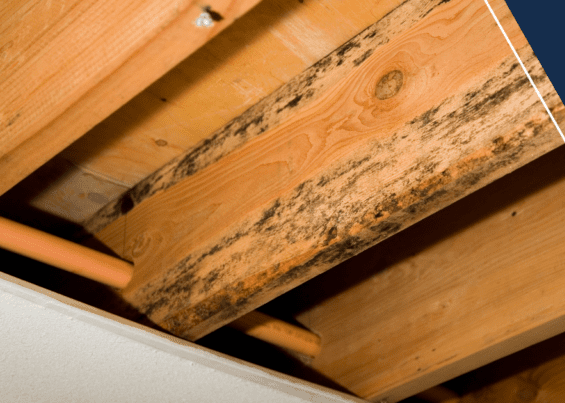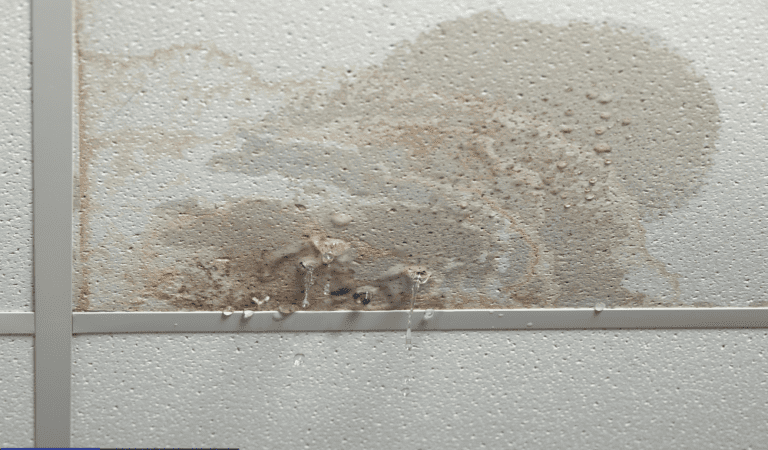Roof Leak Detection With
Top View Roofing
Leaks are inevitable, especially on large commercial buildings. Flat roofs are notoriously prone
to leakage and often experience structural damage if the affected areas aren’t treated quickly.
Roof Leak Detection Services
Roof leaks never get better with time. In fact, they can become much worse very quickly – and if your roof has a leak in it, whether it’s in your residential home or a commercial building you own, it’s in your best interest to call Top View Roofing immediately. Even if you’re not sure where the leak is coming from, our team can come out to your location and find it. Then, we’ll provide you with possible solutions so you can protect your building and hopefully prevent the need for a complete roof replacement.
Roof Leak Detection Services
At Top View Roofing, it is our goal to detect small leaks before they develop into worsening problems, and preventively stop new ones from forming. We achieve this through a variety of proven methods. Our highly trained roofing experts know how to track down the source of a leak and stop it in its tracks.
The Anatomy of a Roof Leak
Sometimes leaks can be tough to find. In some cases, the location you see the water coming from isn’t the actual leak at all. Depending on the severity of the leak, its location, and even its cause, the dripping you can see inside your home or business may be several feet away from the actual leak.
What Happens With a Minor Roof Leak?
Over time, even the most minor roof leak can spell big trouble for homeowners and business owners. That’s because water leaks never get better with time; they only become worse, and sometimes small leaks are a few raindrops away from becoming catastrophic problems. Even small leaks that don’t cause water to drip into your building can cause major issues, such as mold and mildew growth, wood rot and worse.
Some of the most common issues a leaking roof can cause include:
- Mold and mildew issues. Though mold won’t grow immediately, the longer a leak goes undetected, the better chance it has at thriving in your space. Mold can spread through your entire home, even making its way into your HVAC system – and then it can blow around your house, causing health hazards for people and pets.
- Fire hazards. Electrical wiring is at risk for water damage, and when wires get wet, electrical shorts can occur.
- Attic and ceiling damage. A leaking roof can cause serious damage to the items inside your attic – and to your insulation. When insulation becomes wet and soggy, it can’t perform its job; that means you may also see your energy costs increase due to a roof leak. When water makes its way into your main living area or workspace, the paint on the ceiling can bubble and expand; the plaster of the ceiling can become soggy and crumble away. Additionally, leaking water can discolor your ceiling and walls.
- Structural problems. When rafters, framing, ceiling joists and other structural components of your home or commercial building become wet, they can’t support your space the way that they’re supposed to. Structural damage is a common side effect of a leaking roof, and it can even put your roof at risk for collapse. If your roof collapses, it can do such severe damage to the rest of your home (and everything in it) that your insurance company may deem it a total loss.
How Do You Know if Your Roof is Leaking?
The most obvious sign that your roof is leaking is a visible leak indoors. You should never see water coming from your ceiling – but if you do, it’s a good indication that you have a roof leak. However, you should also rule out other causes, such as leaking pipes, before you jump to any conclusions.
The best way to determine whether your roof is leaking is to have an expert inspector from Top View Roofing come to your home or business and check things out for you. If there’s a leak, our inspector will find it. Then, the inspector will explain what steps you need to take to fix it and minimize damage. Our inspector will even give you a quote on the spot so you know what costs you’re facing.
If you don’t see any visible leaks inside your space, there are other signs that can tip you off that your roof is leaking. Watch for signs like these:

- Discoloration and water spots on your ceiling or walls. If your roof is leaking, even if it’s not a current or active leak, you may notice a brown or yellow spot on your ceiling, or even trailing down your walls. That’s because damp or wet areas can collect dirt, pollution and debris.
- Missing shingles or tiles on your roof. Shingles and tiles are your roof’s first line of defense against water, which means when they’re missing, they can’t protect your building like they should. Though missing shingles or tiles isn’t a certain sign that your roof is actively leaking, it’s a sign that water now has a path to make its way into your building. You should have an inspector come check out your roof right away if you have missing shingles or tiles; they need to be replaced immediately, and an inspector can determine whether water has had a chance to make its way into your space yet.
- Missing or damaged flashing. Flashing is the material that covers joints in your roof where things stick out from it, such as your chimney, skylights and vents. If the flashing is missing or damaged, there’s a pathway for water to make its way into your roofing materials.
- Moisture in your attic. Though moisture in your attic can occur for other reasons (such as poor ventilation), there’s a good chance that you have a roof leak if your attic is damp. You may feel the dampness in the air, notice that your insulation is waterlogged, or see water damage on the rafters. (Like it does to ceilings, water can cause staining on your rafters.) You may also see frost buildup on your rafters or other items in your attic during winter.
- Mold growth in your attic or elsewhere in your home. Mold needs a damp, dark place to thrive – and damp attics create the perfect environment. Though moisture can make its way into your attic through other means (such as poor ventilation), it’s a sign that your roof may be damaged and allowing water to come in.
Don't Wait Until Damage Gets Worse.
Top View Roofing’s State-of-the-Art Leak
Protection Technology
Damage caused by leaks can range anywhere from minor water stains and electrical shortages to total structural failure of the roof.
We want to avoid this at all costs. Thanks to advances in leak detection technology, our roofing contractors are expertly trained in the latest practices to treat existing leaks and prevent new ones from forming. We use effective leak-testing methods, including electronic infrared thermal technology. This can detect even the smallest breaches in a roof membrane, allowing our team to rapidly repair leaks well before they cause structural damage.
Because most commercial properties have flat roofs as opposed to sloped, water cannot drain off as easily. This often leads to a collection of water that seeps past shingle layers and into the interior of the facility. Top View Roofing, however, offers a simple solution with our waterproofing services.
With waterproofing roof coatings, we can add a durable barrier to the roof membrane that prevents water from entering through the surface. Waterproofing your commercial roof also insulates the material and prevents energy loss.

Common Roof Waterproofing Materials
There are several ways to waterproof a roof, whether it’s on a residential home or a commercial building. The method your roofer explains to you will depend on the type of roofing materials you have. However, the most common waterproofing techniques include:
- Bituminous membrane waterproofing
- Polyurethane liquid membrane waterproofing
Here’s a closer look at each.
Bituminous Membrane Waterproofing
Bituminous membrane waterproofing is a good option in many cases because it’s:
- UV resistant
- Flexible enough to resist breaking, cracking and denting
- Chemical resistant, which means it’s okay to use on factories
- Resistant to punctures, even during heavy storms that throw around a lot of debris
- Cost effective
Polyurethane Liquid Membrane Waterproofing
Polyurethane liquid membrane is a thin coating that goes on your roofing materials, and people choose it because:
There are no joints, so water is less likely to seep through it
It’s flexible enough to resist cracks as a building moves or settles
Your roofing expert from Top View Roofing will talk to you about your options and provide you with solutions that help keep your roof safe, no matter the weather.
Spotting Leaks: A Homeowner’s Guide
It’s crucial for homeowners to recognize the early signs of roof leaks to prevent extensive damage. Look for water stains on ceilings or walls, which often appear as brownish rings. Peeling paint or bulging patches on interior walls can also indicate a leak. Don’t forget to check the attic; damp rafters or insulation are telltale signs. After heavy rain, inspect your roof for missing, damaged, or aged shingles, as these can allow water to seep through. Regular self-inspections can catch problems early, saving you time and money in the long run.
Your Roof’s Best Defense: Preventive Care
To keep your roof in top shape and prevent leaks, regular maintenance is key. Ensure your gutters are clear of debris like leaves and twigs, as blockages can cause water to back up and damage your roof. Trimming tree branches that hang over your roof will reduce the risk of damage and limit debris accumulation. It’s also wise to schedule professional inspections annually; a roofing expert can spot potential issues that you might miss.
Don't Wait Until Damage Gets Worse.
FAQ About Roof Leak Detection
Check out these commonly asked questions about roof leaks. If you read through them and still don’t see the answers you’re looking for, let us know — we’ll be more than happy to answer your questions over the phone.
What Are the Signs of a Roof Leak?
If you notice water stains that extend across ceilings or run down walls, the cause is likely a leaky roof. Other signs include musty odors in certain rooms, spots on your exterior walls, or bulges in your interior paint. It’s important to address these signs immediately to prevent further damage.

How Often Should I Inspect My Roof?
We recommend having a professional inspect your roof at least once a year and after any major storm as well as doing visual inspections from the ground yourself every quarter. This helps catch potential issues before they become serious. However, if you live in an area with severe weather, more frequent checks may be necessary.
Can I Inspect My Roof Myself?
Yes, you can perform a basic roof inspection yourself by looking for visible signs of damage from the ground. However, for a thorough inspection, it’s best to hire a professional who has the expertise and equipment to identify and address any issues safely.
What Should I Do If I Find a Leak?
If you find evidence of a leak, it’s important to contact a roofing professional as soon as possible. Quick action can prevent a small issue from becoming a major problem.
Will Delaying Leak Repairs Cause More Damage?
Delaying repairs on a detected leak can lead to more extensive and costly damage. Water can deteriorate the structure of your home, leading to issues like mold, rot, and even structural failure. It’s crucial to address leaks promptly to maintain the integrity of your home.
How Can I Prevent Roof Leaks?
Preventing roof leaks starts with regular maintenance. Keep your gutters clean, ensure your roof materials are in good condition, and replace sealants as needed. Also, after any severe weather, inspect your roof for damage or potential weak spots. Preventive actions like these can significantly reduce the likelihood of leaks.
Does Homeowners Insurance Cover Roof Leaks?
Coverage for roof leaks depends on your specific insurance policy and the cause of the leak. Generally, if the leak is due to sudden accidental damage, it may be covered. However, leaks due to wear and tear or lack of maintenance are typically not covered. It’s best to check with your insurance provider for details.
Do You Need to Talk to an Expert About Roof Leak Detection?
If you suspect that your roof is leaking, call our office today to schedule a consultation with a roofing expert. We can answer your questions, inspect your roof and provide you with a quote to fix the problem right away.
Free Roof Leak Inspection
Regular roof maintenance can extend the lifespan of your roof and save money on a premature replacement. As a trusted Dallas roof repair contractor, Top View Roofing will give you peace of mind that your home is protected.
Let us help
Top View Roofing would be happy to answer all your questions and provide you with a free estimate tailored for your building. |Use our confidential Contact Form.
